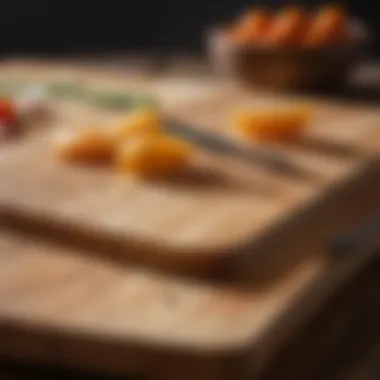Exploring Affordable and Functional Cutting Boards


Intro
In the culinary landscape, cutting boards serve not only as utilitarian tools but also as useful companions in the kitchen. They play a role in food safety, efficiency, and even presentation. Among the vast range of options available, discount cutting boards often get overlooked. Many may dismiss these boards due to their lower price, assuming they sacrifice quality and performance. However, this article is about to illuminate the true value of discount cutting boards.
Discount cutting boards present an attractive balance of affordability and functionality. They come in various materials, from plastic to bamboo, and offer diverse features suitable for different cooking styles. This exploration does not stop at their selection; it extends to the important aspects of care and maintenance, ensuring that your investment lasts longer.
As one navigates through the world of cutting boards, the aim here is to provide insight into their merits, guiding the selection process for the right board that meets both budgetary constraints and cooking needs. Through this discussion, readers will gain a clear understanding of options available and how to maximize their utilization in culinary activities.
Prologue to Discount Cutting Boards
Discount cutting boards are often underrated when it comes to kitchen essentials. Many cooks focus on higher-end products or designer brands, overlooking the advantages that come with more affordable options. Understanding the value of these boards is essential for anyone who spends time in the kitchen. In this section, we will discuss the importance of discount cutting boards, highlighting their benefits and considerations.
One of the primary reasons to explore discount cutting boards is affordability. Cooking is a rewarding endeavor, but high-quality tools can make it costly. Discount options provide a pathway for those on a budget to acquire functional kitchen supplies without compromising quality.
These cutting boards are not only impactful for your wallet but also serve various purposes. They can accommodate different ingredient types, safeguard knife edges, and assist in maintaining kitchen hygiene. For example, certain materials can be more sanitary and easier to clean than others. This topic is vital for those who prioritize food safety in culinary practices.
Another crucial element to consider is the variety available among discount cutting boards. Shoppers often find a broad spectrum of materials, sizes, and designs. This diversity means that, regardless of cooking style or kitchen layout, everyone can find a product that suits their needs.
Choosing the right cutting board brings up important considerations about maintenance and effectiveness. Many might believe that lower-priced options lack durability. However, the reality is that with proper care, even discount cutting boards can provide long-lasting service.
In summary, understanding discount cutting boards opens doors to more accessible kitchen tools, enhancing your experience in the culinary world. They offer an opportunity to support both budget-conscious chefs and those seeking reliable kitchen options.
Understanding Cutting Boards
Cutting boards serve an essential role in food preparation, making it crucial to understand their various aspects. This helps in selecting a board that fits specific culinary needs while ensuring food safety and maintaining kitchen tools. In this article, we will explore the different types of cutting boards, their materials, and their characteristics to provide practical advice for both novice and experienced cooks alike.
Types of Cutting Boards
Wood Cutting Boards
Wood cutting boards have a rich tradition in kitchens worldwide. They are known for their durability and ability to maintain knife sharpness. One key characteristic of wood boards is their self-healing nature, which means that small cuts and grooves can close up over time. This feature minimizes bacterial growth, enhancing their appeal for food safety. However, wood boards require specific care, including regular oiling, to prevent cracking and warping. Some wood options include bamboo, which is sustainable, and hardwood varieties like maple known for longevity.
Plastic Cutting Boards
Plastic cutting boards are very popular due to their convenience and affordability. They are often made from high-density polyethylene, which is easy to clean and dishwasher safe. A significant advantage of plastic boards is their lighter weight, making them easy to handle and store. However, they can develop knife marks that harbor bacteria if not properly cleaned. It is advisable to replace them periodically, especially if they show significant wear.
Composite Cutting Boards
Composite cutting boards combine various materials, usually wood fibers and resin, creating a strong and durable product. They resist warping and can often be used in the dishwasher, making them a practical choice for busy kitchens. Their unique feature is the ability to mimic the feel of wood while offering better moisture resistance. Despite these advantages, composite boards can be unfavorable if they are scored deeply, as bacteria may accumulate in those grooves.
Glass Cutting Boards
Glass cutting boards are visually appealing and provide a non-porous surface for cutting. They are easy to clean and do not retain odors, making them a hygienic option. A primary drawback, however, is their potential to dull knives quickly due to their hard surface. This characteristic necessitates more frequent knife sharpening, which can be an inconvenience for some users. Overall, glass boards can be both decorative and functional, but may require additional maintenance for knife upkeep.
The Role of Cutting Boards in Culinary Practices
Food Safety Considerations
Food safety is a fundamental aspect of using cutting boards. Different materials can affect how well the board inhibits bacterial growth. For instance, wooden boards can naturally reduce bacteria due to their cellular structure, while plastic boards need meticulous cleaning to avoid contamination. A crucial highlight is ensuring boards are washed thoroughly after use, especially when switching between raw meats and vegetables.
Impact on Knife Maintenance
The choice of cutting board has a notable impact on knife maintenance. Certain materials can cause more wear and tear on knife edges over time. For example, glass cutting boards are harsher on blades, whereas wood and high-quality plastic are gentler, helping maintain sharpness longer. Understanding these characteristics allows for better decision-making regarding kitchen tools and overall cost efficiency in the long run.
By comprehending the types and functions of cutting boards, as well as their influences on food safety and maintenance, one can make informed decisions that enhance culinary practices. This careful selection process helps ensure both functionality and satisfaction in the kitchen.


The Appeal of Discount Cutting Boards
Discount cutting boards have gained significant attention among consumers. This interest lies in their ability to offer practical solutions without straining the wallet. Affordable and functional kitchen essentials appeal to many, especially those who seek value without compromising quality.
Affordability and Accessibility
The primary allure of discount cutting boards is their affordability. Not everyone can invest in high-end kitchen tools, especially beginners who are just starting their culinary journeys. Discounted boards often provide a viable option for those who want to enhance their cooking experience without considerable financial expenditure. This affordability does not equate to subpar quality; many discount cutting boards perform adequately for daily needs.
Furthermore, accessibility plays a key role in this appeal. Discount cutting boards are typically available at various retailers. This includes online platforms, local grocery stores, and specialty kitchenware outlets. With a simple search or a quick visit to the store, anyone can find a selection that meets their needs. This ease of access ensures that a wider audience can benefit from using cutting boards that suit their lifestyles.
Variety Available in the Market
Another significant aspect of discount cutting boards is the variety available in the market. Consumers can find a diverse range of options catering to different preferences. These include various materials, sizes, and designs. Buyers can choose from wood, plastic, and composite materials based on their cooking habits and preferences.
This variety means that individuals can select cutting boards that align with their culinary practices. For instance, someone who frequently cooks meats may prefer a plastic board for easier sanitation, while a vegetable-centric cook might opt for a wooden board for aesthetic appeal.
Additionally, the price range can accommodate varying budgets while still ensuring functionality. Even within the category of discount cutting boards, one can find options that look appealing yet perform efficiently. The market continuously responds to consumer needs, reflecting trends in culinary practices and style preferences.
"When purchasing discount cutting boards, utility meets design across different price points, making it easier for everyone to elevate their cooking without overspending."
Material Choices for Discount Cutting Boards
When considering discount cutting boards, the material choice is crucial. The right material can enhance functionality, affect durability, and even influence maintenance needs. Understanding these elements helps buyers make informed decisions. The three most common materials are wood, plastic, and composite. Each has its unique advantages and disadvantages that one should consider.
Evaluating Wood Options
Bamboo
Bamboo is a grass rather than traditional wood. Its rapid growth makes it an eco-friendly choice. This material is lightweight, yet it is surprisingly durable. As a cutting surface, bamboo can resist knife marks better than some softer woods. However, it tends to be less forgiving on knife edges. It is also known to absorb little moisture, reducing the risk of bacterial growth. Thus, bamboo cutting boards can be a great choice for those who value sustainability.
Rubberwood
Rubberwood comes from rubber trees that have reached the end of their latex production. The appealing characteristic of rubberwood is its robustness. It can handle both the cutting and chopping tasks well. Its fine grain prevents bacteria from hiding in grooves, making it hygienic. One downside is its price point. Rubberwood can be more expensive than other wood types in discount cutting boards. However, it is worth considering for long-term use.
Maple
Maple cutting boards are highly regarded by chefs for their toughness. The hardness offers excellent resistance to knife cuts, prolonging the life of the board. Maple also has a close grain structure, which helps prevent food particles from getting trapped. On the downside, it requires more maintenance to keep it in optimal condition. Regular oiling is necessary to prevent drying out and cracking, which could be a drawback for those reluctant to maintain their kitchen tools.
Assessing Plastic Cutting Boards
High-Density Polyethylene
High-Density Polyethylene (HDPE) is a popular plastic choice. Its resistance to stains and odors makes it ideal for food preparation. Moreover, it is dishwasher safe, simplifying cleaning processes. A key characteristic is its ability to absorb shock, which protects knife edges. However, it can score easily, leading to grooves that may harbor bacteria over time. Consider replacing these boards once they become too damaged.
BPA-Free Alternatives
BPA-Free alternatives have gained attention for avoiding harmful chemicals. These plastics ensure safety during food prep. Their key characteristic is flexibility—they can often be shaped into different designs. Like HDPE, they are also easy to clean and resist stains. One disadvantage could be durability. They might not last as long as some wood cutting boards under heavy use.
Composite Cutting Boards Explained
Composite cutting boards blend materials, usually wood fibers and resin. They offer benefits from both wood and plastic cutting boards. They are quite durable and resistant to knife marks. One of the appealing features is that they can usually handle heat better than pure plastic options. However, they can be heavier and less aesthetically pleasing than solid wood options. Understand that while they are versatile, they may also require specific cleaning methods to maintain integrity.
Key Features to Look for in Discount Cutting Boards
When considering discount cutting boards, it is essential to know which features are crucial for optimal performance and longevity. A well-chosen cutting board enhances your cooking experiences and helps maintain safety and efficiency in the kitchen.
Thickness and Size Considerations


Thickness plays a significant role in the functionality of a cutting board. A thicker board, often ranging from 1.5 inches to 2 inches, provides durability and can absorb more impact from knives. This helps to decrease the risk of deep cuts and wear.
Size is also important. Choosing a board that fits comfortably on your countertop eases food prep. Common sizes vary from small boards suitable for simple tasks to larger ones that accommodate significant meal prep. It can make chopping and slicing much more practical. Selecting a size that matches your usual cooking habits can improve your overall kitchen efficiency. The right dimensions save space and add convenience during cooking.
Surface Texture and Design
Surface texture affects both food prep and knife maintenance. A subtle texture can help grip food, preventing slipping while slicing. This safety feature is often overlooked but is incredibly significant. For example, wood boards typically have variances in grain which can impact how food stays put during cutting. This can make a difference in speedy meal prep.
Design also influences user experience. Aesthetic appeal is important, as a cutting board with a pleasing design can enhance kitchen decor. Consider boards that have edges designed to prevent liquids from spilling off the side. This will keep your workspace organized, and clean-up becomes easier as well.
Brand Reputation and Reviews
The reputation of the brand can provide insight into the quality and reliability of discount cutting boards. Opting for well-regarded brands often ensures a certain level of craftsmanship and material robustness. Checking customer reviews can offer tangible insights.
Look for feedback regarding durability, ease of cleaning, and overall satisfaction. Since cutting boards face daily wear and tear, understanding the experiences of other customers can be instrumental in making an informed choice. Saying that a brand has a solid history can signal potential quality, but consider the specific nuances shared by users.
"A good cutting board is an investment in your cooking experience, both in functionality and safety."
In summary, recognizing key features when selecting discount cutting boards can lead to informed decisions that enhance your kitchen experiences. The thickness, size, surface design, and brand reputation all contribute to the value offered by these economical kitchen tools.
Care and Maintenance of Discount Cutting Boards
The relevance of care and maintenance in the context of discount cutting boards cannot be overstated. These boards, despite their lower price point, can provide excellent performance for home chefs. However, their longevity and safety rely heavily on proper care. Taking the time to understand the best practices for cleaning, storage, and prevention ensures that your investment does not go to waste.
Cleaning Techniques for Various Materials
Cleaning is essential for maintaining the quality of discount cutting boards. Different materials require specific approaches to ensure hygiene and durability.
- Wood Cutting Boards: Use warm, soapy water to wash these boards. Avoid soaking them, as prolonged exposure to moisture can lead to warping. For a deeper clean, occasionally wipe them with a vinegar and water solution. This helps in neutralizing odors.
- Plastic Cutting Boards: These boards are usually dishwasher safe. However, hand washing with a mild detergent and hot water is often sufficient. Be sure to scrub any surface stains to eliminate bacteria.
- Composite Cutting Boards: These can be cleaned similarly to plastic boards. Use soap and hot water or the dishwasher if they are labeled as safe for it.
Maintaining cleanliness not only prolongs board life but also contributes to food safety in the kitchen.
Proper Storage Solutions
Storage plays a critical role in extending the lifespan of discount cutting boards. Keeping them in optimal conditions prevents damage and maintains their functionality.
- Flat Storage: Ideally, boards should be stored flat in a cool, dry place. This prevents warping that can occur when they are stored upright or stacked.
- Vertical Storage: If space is limited, consider vertical storage in a dedicated rack. This method can also help maintain airflow around the boards.
- Avoid Heavy Items: Do not place heavy items on top of the boards while they are stored. This pressure can lead to warping and cracking over time.
By adhering to these storage tips, the performance of discount cutting boards can be enhanced significantly.
Preventing Warping and Cracking
Warping and cracking are common concerns with all types of cutting boards, including discount options. These issues can arise from both improper maintenance and environmental factors.
- Oil Regularly: For wooden boards, applying food-grade mineral oil every few weeks helps to keep the wood hydrated. This reduces the risk of drying out, which leads to cracking.
- Avoid Extreme Temperatures: Keep boards away from direct sunlight and heat sources. Fluctuations in temperature can weaken the material, causing it to warp.
- Use on Appropriate Surfaces: Using cutting boards on surfaces that are too wet or unstable can contribute to warping. Ensure the area is dry and stable before use.
Proper maintenance can mean the difference between a cutting board that lasts for years and one that needs replacing after a few months.
By applying these care strategies, you not only extend the life of discount cutting boards but also ensure safe and efficient culinary practices.
Common Misconceptions about Discount Cutting Boards
Understanding the common misconceptions surrounding discount cutting boards is vital for informed purchasing decisions. Many people believe that discount cutting boards must be inferior in quality or durability. This perception can close the door on potential savings, accessibility, and smart culinary choices. By addressing these misunderstandings, consumers can appreciate the value that discount cutting boards offer without compromising on functionality.
Perceived Inferiority in Quality


One of the most prevalent misconceptions is that discount cutting boards are generally of lower quality compared to their higher-priced counterparts. This notion can stem from the assumption that lower price reflects cheap materials or poor craftsmanship. However, many reputable brands produce cutting boards that are both affordable and made from quality materials such as bamboo or high-density polyethylene. These boards can provide the same utility and ease of maintenance as more expensive options.
When selecting a discount cutting board, it is essential to look at the material and design rather than solely focusing on price. A well-made plastic or wood cutting board costing less does not automatically indicate inferior quality.
"Quality can exist at any price point if the right materials and construction methods are used."
It is beneficial to explore customer reviews and ratings to discern the actual performance and reliability of discount cutting boards. When done thoroughly, buyers may find quality boards available at a fraction of the price, providing excellent utility in the kitchen.
Durability Concerns
Another common belief is that discount cutting boards are less durable and won’t stand the test of time. This perspective often arises from anecdotal references to specific poorly made products. While it is possible to find low-quality boards, many discount options on the market are built to withstand regular use. Choosing boards made from solid materials like rubberwood or high-density polyethylene can offer longevity.
In fact, some discount cutting boards are designed with safety and durability in mind. They may feature reinforced designs that resist warping, cracking, or other damage.
To enhance durability further, proper care is critical. Simple actions like regular cleaning, avoiding harsh cleaning tools, and following appropriate storage methods can extend the life of any cutting board.
Making Informed Choices When Purchasing
Making informed choices when purchasing discount cutting boards is crucial for anyone who values quality and functionality in their kitchen. Many might assume that a lower price directly correlates with a lesser product. However, there are numerous options available that offer both affordability and adequate performance. By understanding what to look for, consumers can avoid common pitfalls and find a cutting board that suits their culinary needs without overspending.
Attention to detail is necessary when selecting a cutting board. The material, size, and overall construction impact the board's usability and durability. For instance, a thicker board may provide better stability when chopping, while different materials can affect knife longevity. Knowing what features matter most can significantly enhance the kitchen experience.
Furthermore, the context in which the cutting board will be used is essential. Some boards work better for specific food types, while others may be designed for versatility. Clarifying your personal cooking style can guide the decision-making process more effectively.
Comparative Analysis of Discount Options
Discount cutting boards come in a range of materials and styles. To make a wise choice, an analysis of these options can provide insights into their respective strengths and weaknesses. Below is a detailed comparison emphasizing key features of various discount cutting boards.
- Wood Cutting Boards: Generally revered for their aesthetic appeal and durability. Woods like maple and bamboo are both popular choices. However, they may require frequent maintenance to prevent cracking and warping.
- Plastic Cutting Boards: These are often lighter and easier to clean. High-density polyethylene is a common material that resists cuts and is dishwasher safe. They are also non-porous, which minimizes bacterial growth.
- Composite Cutting Boards: These boards often combine layers of materials and provide a good balance of durability and ease of cleaning. They can resist knife marks better than solid wood.
Ultimately, the choice among these options will depend on personal preferences and intended use. Each type has its merits, making understanding their characteristics a key priority.
Online vs Brick-and-Mortar Shopping
When considering a purchase, consumers have the option between online and brick-and-mortar shopping. Each model offers distinct advantages that can affect the decision-making process.
Online Shopping:
- Convenience: Shopping from home eliminates the need for travel, allowing consumers to browse at their own pace.
- Wider Selection: Online retailers often stock a more extensive range of products than many physical stores.
- Pricing Transparency: Online comparison tools make it easier to find the best deals.
Brick-and-Mortar Shopping:
- Tactile Experience: Physically handling cutting boards allows customers to assess their weight, texture, and size more accurately.
- Immediate Purchase: Taking a product home the same day can be a significant advantage for those in need of a cutting board right away.
- Personal Interaction: Store employees can provide personalized advice and guidance based on customer queries.
Making the informed choice relies heavily on individual preferences and priorities. Considering both shopping methods can lead to a more satisfying experience.
Finale: The Practicality of Discount Cutting Boards
In concluding the exploration of discount cutting boards, it is essential to recognize their significant role in modern culinary practices. These boards present a viable solution for both novice cooks and seasoned chefs. Their affordability does not imply subpar quality but rather offers an accessible entry point into the world of culinary tools.
One primary consideration is the varied materials available. Each type of cutting board, whether wood, plastic, or composite, brings unique benefits. For instance, wood cutting boards are often lauded for their aesthetic appeal and natural antibacterial properties, while plastic boards provide practicality in terms of maintenance. Discount options make these boards more accessible to a wider audience, ensuring that everyone can find a suitable choice for their kitchen needs.
Benefits to consider include:
- Economic Advantage: Discount cutting boards are typically priced lower than their premium counterparts, making them budget-friendly.
- Wide Range of Styles: The market offers numerous styles and designs that cater to various tastes and preferences.
- Functionality Without Compromise: Many affordable options provide similar functionality as higher-end boards, ensuring that users do not have to sacrifice performance for price.
Moreover, the practicality extends beyond initial purchase. Proper maintenance and care can extend the lifespan of these boards significantly. Understanding cleaning methods, storage solutions, and even how to prevent damage is crucial for maximizing their value.
"A well-maintained cutting board, regardless of its price tag, can significantly enhance your cooking experience."
Furthermore, choosing discount cutting boards promotes sustainability by allowing users to invest in multiple boards for different uses. This prevents cross-contamination in food preparation and helps maintain hygiene standards in the kitchen.
In summary, discount cutting boards are not merely economical alternatives; they serve as essential tools in culinary practices. By combining affordability, variety, and maintainability, these boards offer a unique practicality that benefits cooks of all levels. As food lovers navigate their options, understanding the value of these cuting boards may very well transform their cooking experience.















